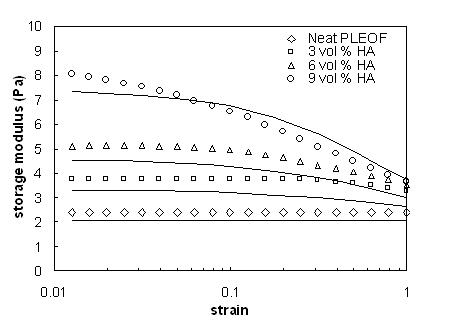670b Modeling and Measurement of Rheological Properties of Poly(Lactide Ethylene Oxide Fumarate)/Hydroxyapatite Nanocomposites
Injectable multiphasic polymer/ceramic composites are attractive as bioresorbable scaffolds for bone regeneration because they can be crosslinked in situ and are osteoconductive. The injectability of the composite depends on the nanoparticle content and the energetic interactions at the polymer/particle interface. A degradable in situ crosslinkable terpolymer based on low molecular weight poly(L-lactide) and poly(ethylene oxide) linked by unsaturated fumarate groups is synthesized. The poly(L-lactide-co-ethylene oxide-co-fumarate) (PLEOF) terpolymer can be blended with nanosized hydroxyapatite (HA) particles to be used as an injectable biomaterial for bone regeneration. The objective of this research is to determine the rheological properties of the PLEOF/apatite composite and to compare the non-newtonian rheological response with a linear elastic dumbbell model. To this end, we performed a series of rheological experiments on uncrosslinked PLEOF reinforced with different volume fractions of HA nanoparticles. Experimental results on the steady state shear viscosity as well as storage modulus in strain sweep show a nonlinear viscoelasticity in material behavior, where the degree of nonlinearity increases with concentration of the dispersed HA nanoparticles. The nonlinear viscoelasticity in our experimental results is attributed to the energetic interactions between the PLEOF chains and HA nanoparticles through the hydrogen bonds between the polar ethylene oxide units of the polymer phase and the ionic groups of the apatite nanoparticles. With reduction of the size of dispersed particles at a constant volume fraction, an enormous surface area of the solid phase is exposed to the surrounding chains. As a result of the energetic interactions between the two phases, a large fraction of the polymer chains adsorb to the surface of nanoparticles. This increases the corresponding relaxation time of the adsorbed chains resulting in enhancement of continuum properties such as viscosity and storage modulus. We proposed an activation model for the lifetime of reversible polymer-particle attachment points. The model implies that the lifetime is a function of its adsorption energy and it varies with the entropic force exerted by the polymer segment at the attachment point. It is demonstrated that the observed nonlinear viscoelasticity is controlled by the amplitude of deformation as well as the deformation rate compared with the kinetic rate of the adsorption/desorption of the chains to/from the surface of the nanoparticles. A linear elastic dumbbell model is proposed to predict the viscometric properties of the nanocomposite at the macroscopic scale. Our model predicts the reduction in viscosity and modulus with increasing shear rate and strain, respectively (see figure).
